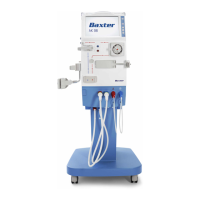72 AK 98™ Dialysis Machine - Technical description
HCEN12630 Revision 07.2015
Program version 1.xx
The limits can be changed in Preset mode.
In order to optimize the dialysis treatment the concentrations of sodium and
bicarbonate in the dialysis fluid can automatically be changed following a
predetermined continuous decreasing or increasing linear graph. Profiling of sodium is
controlled by the A-pump, and profiling of bicarbonate is controlled by the B-pump.
The Flush Valve (FLVA) is used during the priming of the BiCart cartridge. Priming
means that the cartridge is filled up with warm water, and eventually, liquid bicarbonate
comes out at the bottom. This is how it works:
When priming is triggered – either by the fact that the cartridge is placed in the holder
before the machine is started or that the holder is opened during operation – both
concentrate pumps stop. The machine runs, waiting for the measured conductivity (B)
to drop below 2.0 mS/cm.
Figure 3-14. See chapter 11: "Fluid unit - flow path".
Priming starts by opening the FLVA, connecting the flow pumps suction side to the
bottom of the BiCart, and running the B-concentrate pump at full speed. The machine
now waits for the B-conductivity to achieve more than 5.0 mS/cm. This will normally
happen within 60 seconds, if it doesn’t an attention appears. Otherwise, the FLVA is
closed, the B-concentrate pump is stopped, and the machine waits for the
B-conductivity to drop below 2.0 mS/cm. Priming is completed.

